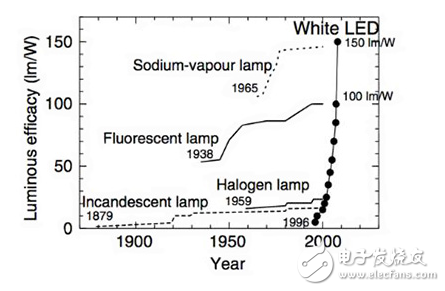
资料下载

基于LED灯具的散热考虑
基于LED灯具的散热考虑
由于使用LED照明灯具(称为灯具在照明业务)变得更加普遍,他们的设计师面临的LED矛盾。虽然LED比白炽灯泡效率高得多(图1),它们的最大允许工作温度要低得多,而且在工作温度限制下也很难保持。[注:可见光LED发光效率约为100流明/瓦,相比约15流明/瓦白炽灯。]在热强度的差异部分是由于玻璃,白炽灯泡的特种金属,陶瓷,固有可以容忍更多的热量比LED封装。

Figure 1: The luminous efficacy of LEDs (often informally confused with their efficiency) has increased dramatically over the years and is now five times to six times better than incandescent bulbs; ironically, the thermal issues and associated dissipation challenges are far more difficult for LEDs.
However, a large part of this difference is due to how the LED manages its own heat compared to a traditional bulb. Thermal physics shows that there are three ways for heat to travel from its source to a cooler sink:
Radiation, where the heat energy leaves as electromagnetic infrared waves. (Note that this is the only choice in the vacuum of space, making the cooling of spacecraft a real challenge.)
Conduction, where the heat travels through a solid or static liquid.
Convection, where the heat is carried away by a moving fluid (a gas, usually air, or a liquid in some advanced designs).
声明:本文内容及配图由入驻作者撰写或者入驻合作网站授权转载。文章观点仅代表作者本人,不代表电子发烧友网立场。文章及其配图仅供工程师学习之用,如有内容侵权或者其他违规问题,请联系本站处理。 举报投诉
- 相关下载
- 相关文章








